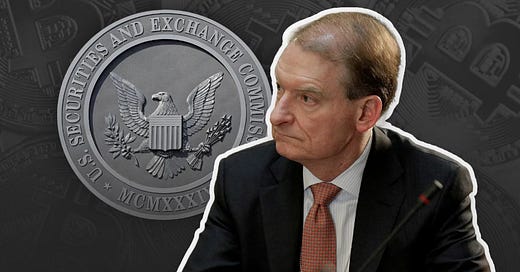Understanding Web3 Legal - U.S. SEC Chair’s Keynote on Tokenization: A Turning Point for Crypto Policy? - Issue 16
On May 12, 2025, SEC Chairman Paul S. Atkins delivered a keynote address at the Crypto Task Force Roundtable on Tokenization. It wasn’t just another regulatory talk—it felt like a statement of intent. And for those of us building at the intersection of crypto, capital markets, and regulation, it’s a signal worth watching.
Below is a breakdown of the key points—and what they may mean for the future of tokenized finance.
1. Tokenization is Now Institutional
“Tokenization is not theoretical—it’s happening.”
From JPMorgan’s Onyx to the EU’s DLT pilot regime, tokenization is no longer a crypto-native concept. It’s being shaped by TradFi incumbents with deep infrastructure and regulatory ties. Atkins acknowledged this shift, underlining that the U.S. can’t afford to treat tokenization as a niche experiment.
As someone who advises tokenization projects from the Gulf to the Caribbean, I’ve seen how fast this is moving—especially in regulatory-forward hubs like Dubai, Singapore, the Cayman Islands, and BVI. The U.S. is officially late to the race. But this speech might be the first step toward catching up.
2. The Call for Regulatory Clarity is Getting Louder
“The U.S. must play a leading role in shaping the regulatory landscape for tokenization.”
Atkins clearly understands that ambiguity drives innovation offshore. His emphasis on regulatory clarity echoes what founders, asset managers, and even banks have been saying for years: if the U.S. wants to lead, it needs to provide pathways—not just enforcement actions.
We’ve been helping clients navigate Singapore’s sandbox, the VASP regime in Dubai, and tokenization pilots in Abu Dhabi. With the U.S. finally stepping into the arena, the global map may shift—again.
3. U.S. Legal Frameworks Are Outdated—and They Know It
“Our rules weren’t designed for digital-native assets.”
Hearing this from the SEC Chair is meaningful. The Howey Test and the ‘33 Act are struggling to keep up with tokenized bonds, real estate, or revenue-sharing NFTs. Atkins didn’t promise new rules, but he did hint that the current regime is insufficient. That’s an opening.
If Congress or the SEC were to introduce tailored frameworks for tokenized RWA (Real World Assets), we could see a boom not just in token creation—but in secondary markets, liquidity infrastructure, and institutional adoption.
4. Infrastructure Questions Remain
“The lack of standardization in smart contracts and custody remains a challenge.”
Yes, the vision is big—but the rails are still under construction. Custody, wallet recovery, and smart contract auditing are still inconsistent across jurisdictions. If the U.S. wants to lead here, it needs to invest not just in legal reform, but in supporting the technical stack—perhaps through grants, pilots, or public-private infrastructure efforts.
5. RWA Tokenization ≠ Crypto Casino
“Let me be clear: tokenization of real-world assets is not the same as cryptocurrency speculation.”
This distinction matters. By drawing a clear line between speculative digital assets and compliant tokenized financial products, Atkins gave institutions the political cover they need to re-engage. This is the tone shift we’ve been waiting for.
Conclusion: Tokenization’s Next Chapter Will Be Global—and Compliant
This keynote was the strongest indication yet that the U.S. is preparing to treat tokenization as a capital markets innovation, not a regulatory threat. It’s a shift we’ve already seen in Dubai, the Caymans, and Singapore—and it’s encouraging to finally hear a similar tone in Washington.
If the U.S. aligns its policy tools with this vision, we may see RWA tokenization evolve from niche use case to institutional standard. I believe this will be one of the defining battlegrounds of the next financial cycle.




